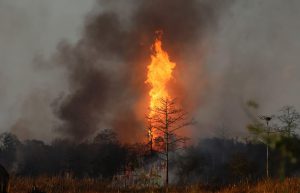The economic recovery from Covid-19 needs to be green. The devil, though, is in the details: policies that offer the best returns for government spending while moving us closer to reaching net-zero emissions need to consider income and gender inequality.
A study published in May by the University of Oxford found that investing in projects which simultaneously aim to reduce greenhouse gas emissions while boosting economic growth deliver high returns on government spending in both the short and long-term. There is also evidence that such projects can create ‘shovel-ready’ jobs that are compliant with coronavirus-induced social-distancing requirements. Additionally, green stimulus packages help uphold national commitments to cut carbon emissions under the Paris Agreement.
A column published on World Bank Blogs states that governments need to consider a number of factors before rolling out green stimulus packages. The eventual common goal should be that no government, acting in haste to control an unprecedented crisis and dodge unavoidable criticism, initiates a project with attractive and marketable characteristics but no real backbone over the long term.
While many believe China is embracing a green recovery by planning construction projects that deliver a low-carbon economic stimulus, the country is simultaneously loosening restrictions on the construction of new coal-fired power plants. India and Bangladesh seem to have largely overlooked green stimulus packages in their Covid-19 recovery plans.
In comparison, there is progress and hope in Pakistan’s ‘Green Stimulus’ package. It is aimed at “job creation and the restoration of our natural ecosystems”, as Malik Amin Aslam Khan, Pakistan’s chief climate change adviser, wrote recently for The Third Pole. The package is an extension of the existing Billion Tree Tsunami project. It is commendable that the green stimulus has already created a reported 65,000 jobs for daily wage workers and envisions employment for 600,000 more in the second phase, even though this is dependent on securing approximately USD 600-100 million through donor funds. It is especially creditable that the promised focus of job creation is on women and young people.
But there are questions about whether large-scale investment in planting trees is the best way to mitigate climate change; whether the effectiveness of trees as carbon sequesters (trees act as natural carbon sinks and absorb the carbon present in the atmosphere) has been considered and why alternative, or even supplementary, green projects to revive Pakistan’s national economy haven’t been given strong priority.
There is no doubt that tree plantations help ecosystems recover and provide a variety of benefits for wildlife and people. They protect mature natural forests from deforestation, encourage certain wildlife species, sequester atmospheric carbon warming and provide employment. Afforestation drives are green glue that bring together governments, civil society organisations and the beneficiaries.
However, human-planted forests need to be maintained for decades before their benefits as carbon sequesters and wildlife sanctuaries are realised. More often than not, they are cut down before then to clear land for farming. A study of regenerated forests in Costa Rica between 1947 and 2014 found that 50% were cleared within 20 years, while in Brazil and Peru they were cleared after only a few years. Many wildlife species also never really acclimatise to monoculture tree plantations and require mature tropical forests to thrive.
It is an additional obstacle for the success of Pakistan’s ‘Green Stimulus’ package that a (now outdated) 2010 report by the National Environment Information System, referred to in a scathing Lahore High Court ruling, says that Pakistan has one of the highest rates of deforestation in the world, between 0.2% to 0.5% per annum.
It will not be possible to reap the long-term intended benefits of the green stimulus unless the existing deforestation rate is reduced, and forest restoration success vigilantly monitored through satellite and neutral local organisations on the ground.
Many factors affect whether trees serve as effective carbon sinks, including the species, their age, and the soil and topography in which they are planted. There are also concerns about the planting of non-native trees which can actually harm ecosystems, discourage local species from inhabiting the area and trigger wildfires.
Planting trees is therefore a welcome initiative, but can distract attention and redirect funds from other, more effective, measures that can mitigate climate change and generate jobs. Some examples of other green projects include investing in renewable energy infrastructure, expanding the availability and accessibility of broadband to encourage working from home, redesigning roads for cycling and building flood protection.
Pakistan can consider all of these options and more, such as expanding its renewable energy sources, subsidising solar energy installation and integrating renewables with electric vehicles and their charging infrastructure. This last option in particular should be a priority for the China–Pakistan Economic Corridor – the Pakistani component of China’s Belt and Road Initiative infrastructure projects. Our planet and trade practices need heavy-duty electric trucks more than they need coal power plants that are marketed as ‘eco-friendly’.
The government can also use this moment to invest heavily in education to raise awareness and in training on eco-friendly agricultural practices. Currently, women in Pakistan are underrepresented in the technology and manufacturing sectors. Our green policies must be inclusive, and investment in R&D and training for women is an ideal starting point.
Climate goals were ignored in the aftermath of the 2008 financial crisis, when a desperate attempt to boost construction, mainly through the use of fossil fuel-powered steel and cement production, caused carbon emissions to rebound. This time our recovery must advance climate goals.
Almost every country in the world will need to rebuild their economic engines to kick-start their journeys out of recession. Recovering from the Covid-19 economic crunch should not push climate change to secondary status relative to economic recovery, or erase the decades of painfully cultivated sense of urgency around climate action.
![<p>Initiatives like electric trucks should be a priority for the China–Pakistan Economic Corridor [image by: Awais Yaqub / Alamy]</p>](https://dialogue.earth/content/uploads/2020/06/HX1XYP-2-scaled.jpg)








